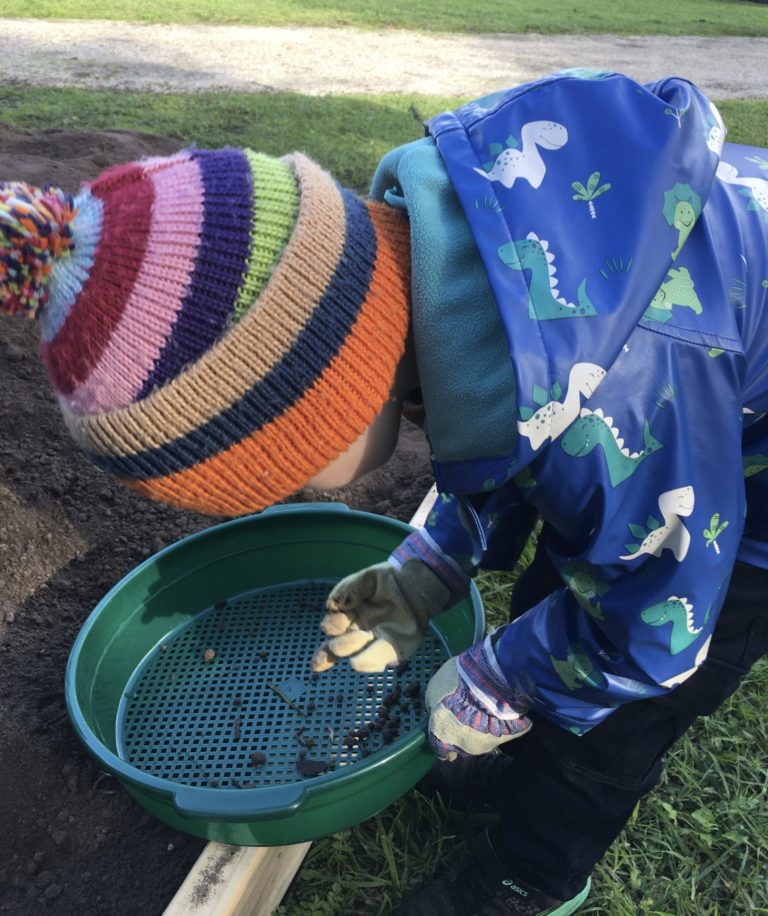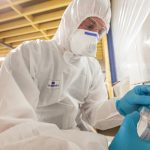The launch of an immersive archaeology program encourages students in regional Victoria to get hands-on with Australian history.
Geelong schoolteachers welcome the innovative new program, run by the National Trust of Australia (Vic) – an independent not-for-profit organisation focused on conserving and protecting Australian heritage for future generations.
The program enables students to experience archaeology – the study of the material cultural remains of people from the past – and has been developed in collaboration with archaeologist Dr Georgia Stannard from La Trobe University.
Exploring history beyond text books
Archaeology: Beyond the Written Record is led by a trained archaeologist – the Dig Director – who guides primary, secondary and VCE school students through a simulated archaeological investigation to excavate and collect evidence.
This unique exploration of history will happen at Barwon Grange – the only surviving example of the many fashionable river front residences built along the Barwon River during the 1850s and 1860s for the wealthy of the coastal town of Geelong, around 80 kilometres from Melbourne.

“This unique program introduces students to different ways of thinking about history, exploring the ways that archaeologists use the everyday objects of the past to travel through time and space to reconstruct past peoples and the landscapes in which they lived,” says Dr Stannard.
Funding supports expansion of education programs
After successfully launching their first archaeology program at Como House in 2023, the National Trust of Australia (Vic) saw an opportunity to bring this immersive archaeology experience to the students of the greater Geelong region.
The National Trust of Australia (Vic) was recently awarded funding from the Victorian Department of Education as part of the Strategic Partnerships Program (SPP) which provides funding to not-for-profit organisations to deliver curriculum enrichment and enhancement programs that improve student achievement.
With this funding, the National Trust of Australia (Vic) can expand its reach and will provide learning opportunities in history and archaeology that are not available in mainstream classrooms.
“This program supports students to actively engage in their learning. With guidance from our Dig Director (a trained archaeologist), students use what they have been learning in class to analyse material culture (artefacts) they find in one of our simulated archaeology sites,” National Trust Education and Public Programs Manager Nicola Dziadkiewicz told EducationDaily.
“This program provides students with the opportunity think critically, and to learn the skills and processes of archaeology by exploring the tools and techniques that archaeologists use to reconstruct the lives of past peoples and the landscapes in which they lived.”

Giving teachers and students confidence to dig deeper into Australia’s past
With archaeology being relatively new in the Australian Curriculum, Ms Dziadkiewicz told EducationDaily teachers are provided with a comprehensive resource that includes suggested activities and lessons to implement before and after the program. The resource aims to support teachers to incorporate archaeological methods and archaeological thinking into their practice with confidence.
Ms Dziadkiewicz says the program also supports students to actively engage in their learning.
“This program provides students with the opportunity think critically, and to learn the skills and processes of archaeology by exploring the tools and techniques that archaeologists use to reconstruct the lives of past peoples and the landscapes in which they lived.”
People have lived in Australia for at least 65 000 years – “approximately 2,600 generations”, she says.
But although we know quite a lot about communities in the past – their technologies, food, resources and culture – Ms Dziadkiewicz told EducationDaily that, “when students learn about archaeology, they develop better understanding about how we know these things”.
“Digging into the past and analysing what we find guides students to understand how we know these things, and how we know when they happened.”
Cultural history pre-dates written histories
With at least 99.6 per cent of cultural history occurring before the recording of written histories in Australia, she says archaeology plays an essential role in the recognition and appreciation of the many diverse and exciting chapters in our national story.
“Students roll up their sleeves, pop on some gloves, and use tools just as archaeologists do. Shovels, trowels, buckets, brushes and pans, sieves are all utilised in this hands-on, multisensory learning experience,” she told EducationDaily.
Senior Producer at Monash University, Ruth Oakley, says working with professional archaeologists is very inspiring for children.
She reflected on her own children’s experience at another National Trust historic home to highlight the impact it can have.
“Archaeology at Como House appealed to both my seven and 11-year-olds, who found it exhilarating to uncover artefacts – an antique teaspoon, pieces of patterned crockery and many more treasures revealed, ” Ms Oakley told EducationDaily.
“Also learning about deeper time and the relevance of the site to First Nations people. The program provides a powerful lens to explore historic houses and landscapes, made all the more memorable for how expertly the dig is delivered. The students were treated just like a mini team of archaeologists in training.”
Finding new beginnings to old stories
Such training, says La Trobe University’s Dr Stannard, is an important extension of traditional classroom-based learning.
“In Western education, the discipline of history is almost exclusively taught through the analysis of the written word. The earliest forms of writing are first seen within the archaeological records of the Near East around 5,500 years ago; but that is not where our story begins,” she told EducationDaily.
“After leaving Africa, more than 90 per cent of the knowledge, culture and science of our ancestors had been amassed before the development of writing. It is for this reason that archaeology – the recovery, analysis and interpretation of the objects and places of past peoples – is essential to understanding our global human story.”
Understanding First Nations culture
Archaeology, she says, also plays a vital role in telling our collective human story here in Australia, by complementing millennia-old oral traditions and knowledge pathways of the hundreds of diverse Australian First Nations cultures.
“Archaeology is a highly engaging field of study, and is ideal for hands-on, experiential learning to develop critical and creative thinking about past people and places. It is also an ideal medium to engage with contemporary cultures, building cross-cultural capabilities and providing the foundations for discussions on cultural ethics,” says Dr Stannard.
She looks forward to seeing school students connect with what she describes as “a naturally engaging discipline”.
Calling a new generation of ‘time detectives’
“As time detectives, we carefully collect, analyse and interpret evidence – everything from microscopic parasites to entire landscapes – to reconstruct the lives and cultures of people in the past and the places where they lived,” she says.
“There is a modern misconception that history is both unengaging and boring. This program redefines the foundational experiences that students have with history. By utilising experiential, object-based learning, students experience history-making for themselves by recovering, investigating, and interpreting evidence of the past.”
For children daydreaming about a career as an archaeologist, Dr Stannard says it is important to correct the many misconceptions about modern archaeology – particularly archaeology in Australia.
“Archaeology today is a highly multidisciplinary field, with teams often comprising scientists from many different backgrounds, including geomorphologists, anthropologists, chemists, and dating experts,” she told EducationDaily.
“One field, however, that rarely overlaps with day-to-day archaeology is palaeontology – the study of fossilised plants and animals. Archaeology is limited to evidence left behind by people in the past, and while we do use similar scientific techniques to palaeontologists, we don’t research dinosaurs!”

A sector rich with potential
With a huge range of jobs available for archaeologists around the world – and in Australia – Dr Stannard told EducationDaily the sector has one of the highest employment rates for graduates in the country
“Australia has an incredibly rich and diverse archaeological record extending back at least 65,000 years, which includes submerged archaeological landscapes along the northwest coast, the oldest aquaculture system in the world at Budj Bim in Victoria, and rock art sites of outstanding beauty and complexity,” Dr Stannard told EducationDaily.
“With a hugely varied job description, including excavations, surveys, lab work, public interpretation, and policy development, archaeology presents an ideal career choice for anyone interested in researching people and places of the past.”
Teachers play a significant role in encouraging future explorers of the past
Her own successful career in archaeology has, she says, “been strongly influenced by passionate educators”.
“My interest in archaeology began in Year seven, fostered by my dynamic and thought-provoking history teacher,” Dr Stannard told EducationDaily.
“I was thrilled to have found a discipline in which I could combine my love of history, science, and geography, and I continued in these fields through to university, completing a Bachelor of Science (Palaeoenvironments and Marine Geoscience) and Bachelor of Arts (Archaeology and Biological Anthropology) at the Australian National University.”
During her time at the ANU , she was introduced to the archaeology of Australia’s First Nations communities – something she remembers as a pivotal moment in her professional pathway.
“A field school led by the inspiring Aboriginal and Torres Strait Islander archaeologist Dave Johnston solidified my intention to specialise in this area of Australian archaeology, and I have been working in this area ever since,” she told EducationDaily.
Since then, she spent “years working in the Cultural Heritage Management sector”, before returning to the ANU to complete a Master of Archaeological Science and going on to a PhD at La Trobe University in molecular archaeology.
“Teaching has always been a great love, and I have been incredibly lucky to have been able to pursue archaeological education both with the National Trust of Australia (Victoria) and as a Lecturer in the Department of Archaeology and History at La Trobe University,” she says.
“I firmly believe that the shortest route to shifting the national narrative on Australia’s deep time history is through our classrooms; the National Trust of Australia (Victoria) programs present the first step to making that a reality.”








